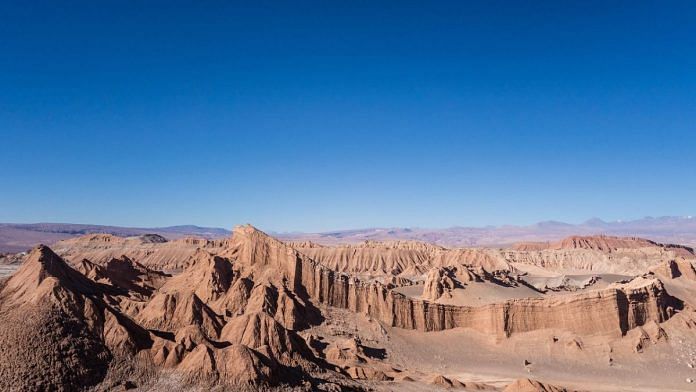New Delhi: There is a sun-soaked place on Earth that receives as much sunshine as the surface of Venus and it is in Chile’s Atacama Desert. The Altiplano plateau of the Atacama Desert gets the most intense sunlight on our planet, according to a report published in the Bulletin of the American Meteorological Society.
The report also said satellites have consistently pointed to Altiplano as the place on Earth where the world’s highest surface irradiance occurs. But Raúl R. Cordero, a physicist at the University of Santiago in Chile, and his colleagues wanted to collect data in real-world settings.
For this, they set up a small atmospheric observatory in 2016 at the northwestern border of the Chajnantor Plateau in northern Chile and have been measuring solar radiation levels using a pyranometer — a palm-sized instrument sensitive to ultraviolet, visible and near-infrared light.
The high altitude Altiplano plateau in the Atacama Desert straddles parts of Chile, Bolivia, Peru and Argentina. It hosts major astronomical projects, including the Atacama Large Millimeter/Submillimeter Array (ALMA) and the APEX (Atacama Pathfinder Experiment) — a 12-metre diameter antenna observing the universe at millimetre and submillimetre wavelengths. While normally cold and dry, the Altiplano sits at an elevation of roughly 13,120 feet, that is, 4,200 meters.
From the measurements made at the observatory set up by them, the scientists found that Altiplano receives the highest-known irradiation on Earth and “illuminates the unique features of surface solar extremes at high-altitude locations”, their report noted.
The average measure of solar power hitting each square meter of the landscape in Altiplano— 308 watts — was found to be consistent with earlier satellite observations. Experts have also noted that solar energy potential in the Altiplano is roughly, on average, twice as high than in Central Europe and the US East Coast.
The researchers were also able to capture bursts of extremely intense solar radiation during their study.
Also read: The UFO buzz is passe—NASA has a new term for it. Here’s why we’re still fascinated
Why Altiplano
The report reasons that due to its high elevation and proximity to the equator, the Atacama Desert stands out among other major solar hotspots. The region also has a thin atmosphere and low concentration of absorbers and scatterers that favor extremely high clear-sky Shortwave (SW) irradiance.
The global horizontal SW irradiance, which is about 240 W m−2 on the Tibetan Plateau, climbs to about 275 W m−2 in the Atacama Desert, and further peaks at values as high as 300 W m−2 in the Altiplano.
The scientists also captured bursts of extremely intense solar radiation. In January 2017, there was a blast at the site, with 2,177 watts per square meter — more than seven times the average — of solar radiation. The intensity of that burst and others like it rivals solar radiation on Venus, which is over 40 million kilometers closer to the Sun than Earth is, the ScienceNews reports.
Through their research, the scientists were able to conclude that surface SW extremes registered on the Chajnantor Plateau — where the observatory was set up — are “unparalleled” worldwide. The plateau offers for a strong forward scattering by broken clouds that often makes SW irradiance far exceed the clear-sky ceiling. And their measurements showed that these cloud enhancement events occurring on the Chajnantor Plateau happen at a frequency, intensity, and duration not previously seen anywhere in the world.
Also read: 600 mn-yr-old water droplets found trapped in Himalayas could hold answers to how life evolved



